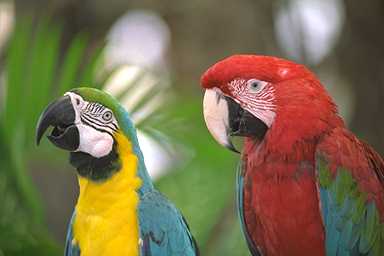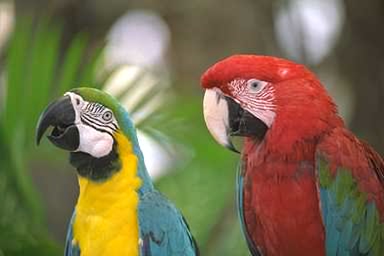
| Previous ... | JQT Home ... | Frequently Asked Questions ... |
|
|
Image Enhancement: Sample ImagesIn some applications, a JQT is added to a network architecture to improve the image quality for end users, rather than maintaining a constant image quality while reducing bandwidth. In this section, we show an example of quality enhancement. A 24-bit color display is necessary to fully appreciate this example: 8-bit displays use color mapping techniques with artifacts of their own, which are not helped by the JQT processing. The image below is compressed using the quantization tables recommended in the JPEG standard. Most commercial and free JPEG encoders use linear scalings of these tables to provide a filesize vs. image quality tradeoff. The image below was compressed using a unity scaling of the tables, achieving a compressed filesize of 9287 bytes. |

|
Sample image, compressed in accordance with JPEG standard recommendations. Note artifacts around parrot heads and beaks. |
|
Note the moderate image quality: the image basically looks OK, but some compression artifacts are noticeable. In particular, notice the color ringing around the head of the parrot to the right, and the artifacts around the beak of the parrot to the left. When measured using our perceptual error metric, which compares the image quality of the uncompressed and compressed images, it receives a score of 0.0253. When our JQT is applied to this test image, it improves the subjective image quality by reducing the compression artifacts, as shown below. |

|
Above image, after processing with JQT. Notice the reduction of artifacts around parrot heads and beaks. |
|
When measured by our perceptual error metric, it achieves a score of 0.0238. To put this number in perspective, the JPEG standard recommends halving their recommended quantization tables, in order to achieve an image quality that is "usually perceptually indistinguishable" from the original image. When compressed with the indistinguishable tables, this sample image achieves a perceptual metric score of 0.0193. Ideally, our JQT could reduce the perceptual error score of the original image from 0.0253 to this "perceptually indistinguishable" 0.0193 : we define this ideal situation to be 100 percent perceptual error reduction . In practice, it reduces the perceptual error to 0.0238. We can express the JQT performance as the percentage value 100*((0.0253-0.0238)/(0.0253-0.0193)) = 25 percent. To use a more common signal processing metric, our JQT improves PSNR (peak signal-to-noise ratio) by 0.58 dB; if the JQT was able to improve the original image to "usually perceptually indistinguishable" it would have registered a 2.44 dB improvement. We measured the percentage reduction of artifacts over an independent test set of 132 images (nominally 384 by 256), and found an average perceptual error reduction of 31 percent, and an average PSNR improvement of 0.56 dB. |
| Previous ... | JQT Home ... | Frequently-Asked Questions ... |
|
|
|
|